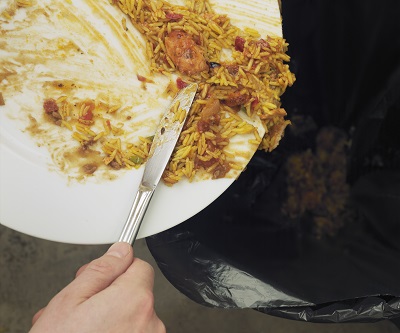How to reduce food waste, what to do with leftover and surplus food, how to reduce packaging waste and single use plastic.
Objective 7 of the Bristol Eating Better Award outlines 8 actions you can do to reduce your food waste, deal with surplus food, ensure energy is recovered from wasted food, and reduce your use of single use plastics and packaging.
For more detailed guidance about the actions see the
pdf
guidance document(904 KB)
.
Food waste from the hospitality and food service sector
The UK's hospitality and food service sector throws away 1.1 million tonnes of food each year, three quarters of which is avoidable. The charity WRAP (Waste & Resources Action Programme) estimates that this costs the industry £3.2 billion every year. These are the costs of preparing, cooking and serving wasted food, as well as the wasted cost to businesses of ingredients, energy, water, transport, administration and waste management. This video Go to https://www.youtube.com/watch?v=VGTPKKOVoz4 (opens new window) illustrates the cost of food waste.
The UN's Food and Agriculture Organisation estimates that if global food waste were a country, it would be the third largest emitter of greenhouse gases after China and the USA. When we waste food, it's important to remember that we're not just wasting the food, its packaging and the money we've paid for it but also all the resources that have gone into producing it before it even gets to Bristol such as land, water, energy and labour.
Avoidable and unavoidable food waste
Food waste can arise at various stages of food and drink service, such as:
- preparation
- stock wastage
- kitchen overproduction
- customer leftovers

Avoidable food waste is food and drink thrown away that at some point prior to disposal was edible (such as fruit and vegetables and sandwiches). This could be because:
- too much food was prepared or bought
- it has gone past its use by date
- it has been spoiled by an accident
Customer leftovers are a major source of avoidable food waste.
Unavoidable food waste is waste arising from food or drink preparation that is not, and has not been, edible in normal circumstances. For example, tea bags, coffee grounds, pineapple skin, eggshells, meat and fish bones.
Disposing of food waste
How we dispose of food waste has a big impact because if it's thrown away in general waste the energy the wasted food contains is not recovered and it releases greenhouse gases when it decomposes. If you can't prevent food waste, recycle and compost as much of it as you can. Recycled food waste is processed using anaerobic digestion which produces clean energy. In Bristol, this energy is used to power homes. Find out how GENeco process food waste at their site in Avonmouth Go to https://www.geneco.uk.com/our-services/food-waste (opens new window).
Food packaging
Single use plastics in the hospitality sector have a big impact on the environment, because these items usually cannot be recycled and are often left as litter on our streets. Plastics tend to be made from non-renewable fossil fuels and they don't biodegrade so remain in the environment for hundreds of years, often causing harm to wildlife.
Provide reusable cutlery and crockery that can be washed, instead of disposable items. This can have a big impact on the amount of avoidable waste your business produces.
Some plastic packaging is beneficial because preserves and extends the shelf life of food.
Hints and tips to reduce food waste
Follow the principles of the waste hierarchy. This not only helps the environment but saves you money too.
Waste hierarchy principles
1. Prevent
- Stop food waste from being generated in the first place. For example, talk to your customers about the food left on plates and manage stock well in your kitchen and storeroom.
- Switch to reusables to reduce the amount of disposable food packaging you hand out. For example, provide reusable cutlery and crockery, or encourage your customers to bring their own containers for takeaway food and drink.
- Sign up as a Refill Bristol station Go to https://www.refill.org.uk/get-involved/add-refill-station/#:~:text=To%20get%20started%2C%20you%20first,types%20of%20Refill%20you%20offer. (opens new window) to allow people to fill their water bottles for free.
- Buy products with as little single use packaging as possible.
2. Redistribute
- Donate surplus food stock to community groups.
- Offer leftover food to customers at a reduced price at the end of the day. You can use apps such as Too Good to Go or Olio for this.
3. Recycle
- Put food that is no longer safe to eat in a segregated food waste recycling or composting bin and have it collected by a waste contractor for energy recovery. This can also help to save money on overall waste costs.
Other ways to reduce food waste
- Monitor your food waste so you can track your progress and the impact of your actions to reduce it.
- Take inspiration from campaigns. There are lots of campaigns supporting food businesses to reduce their food waste, such as WRAP's Guardians of Grub Go to https://guardiansofgrub.com/ (opens new window). Their website has a calculator Go to https://guardiansofgrub.com/cost-saving-calculator/ (opens new window) to help you work out how much food and money you could save. The Love Food Hate Waste website Go to https://www.lovefoodhatewaste.com/ (opens new window) also has lots of resources including recipes for using up leftover food that is safe to eat.
- Take inspiration from others. Many businesses across Bristol took action on food waste to support Bristol's successful bid to become a Gold Sustainable Food City. You can find case studies about some of these businesses at Going for Gold guide to reducing food waste Go to https://www.goingforgoldbristol.co.uk/wp-content/uploads/2019/07/Guide-to-food-waste-reduction.pdf (opens new window).
Page last reviewed: 5 October 2022


